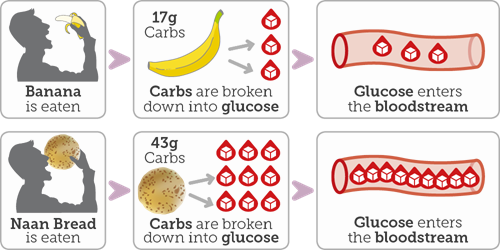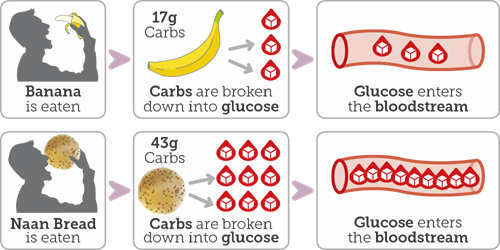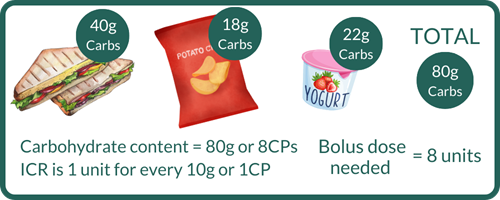Carbohydrate Counting
Contents
- Introduction
- The impact of carbohydrate on blood glucose
- The role of carbohydrate counting in the management of blood glucose
- Different insulin regimens
- Calculating the bolus dose
- Counting carbohydrates
- Insulin bolus dose adjustment and carbohydrate counting
- Useful resources
Introduction
Carbohydrate counting is useful for people (usually those with type 1 diabetes) who use a bolus insulin regime to more accurately estimate their mealtime insulin doses. It is also useful for people with type 2 diabetes to have an awareness of the amounts of carbohydrate in food, particularly if they have regular insulin injections.
The impact of carbohydrate on blood glucose
Carbohydrate is a nutrient that forms a large part of our diet and provides our bodies with an important source of energy.
When you digest carbohydrate it breaks down and is turned into glucose. This glucose then enters your bloodstream. When insulin is available in your body, the glucose is carried into your cells to provide energy. The image below is an example of how starchy carbohydrate foods are broken down. One glucose icon 


The increase in your blood glucose level from the carbohydrates you have eaten and digested will depend on the following factors:
- The amount and type of carbohydrate you have eaten
- Your levels of activity and whether you have done any exercise
- The availability of insulin (if you use it), as well as the type taken, the dose and when you took it
The role of carbohydrate counting in the management of blood glucose
Because carbohydrate has a direct effect on your blood glucose, carbohydrate counting can be a useful tool to help you manage your blood glucose levels.
For you to achieve the perfect balance of blood glucose, the amount of carbohydrate you eat needs to be balanced with the amount of bolus insulin you take. There are two ways to approach this:
- Eat similar amounts of carbohydrate at the same time each day.
- Learn to adjust your bolus insulin dose to match the amount of carbohydrate you eat.
Understanding and applying the principles of carbohydrate counting will help you keep your blood glucose levels as close to normal as possible.
Different insulin regimens
The type and amount of insulin you take will determine which of the two approaches will be better for you.
Twice-daily mixed insulin regimen
Insulin taken twice daily, at breakfast and at your evening meal, may contain a mixture of quick-acting and intermediate-acting insulin, e.g. Humulin M3 or Novomix 30. If you are on this regimen you cannot adjust your insulin according to your carbohydrate intake, but you can count carbohydrates so that you maintain a similar amount of carbohydrate at meals.
Multiple daily injection insulin regimen / basal bolus therapy
This regime includes an injection of bolus insulin, e.g. Humalog or Novorapid, at each meal. If you are on this regimen you can adjust your bolus insulin each time. The amount of bolus insulin you need is directly related to the amount of carbohydrate you consume.
Counting carbohydrates
The first step in the process is to identify all food and drink items that contain carbohydrate.
There are various resources that can help, including
- carbohydrate reference lists/counting tables
- food diaries and labels
- household measures, e.g. scales, cups, spoons
- apps, e.g. MyFitnessPal
- reference books, e.g. Carbs and Cals or Cook and Count
Next, you need to work out the carbohydrate content of all the foods and drinks you consume.
Carbohydrates can be counted in two ways: in grams or as carbohydrate portions. One carbohydrate portion (CP) is equal to 10 g of carbohydrate.
Your diabetes care team will talk to you about which counting method is used at your centre. The following example shows how to count grams of carbohydrate.
Example: Using a carbohydrate reference list (grams)
|
Lunch |
Carbohydrate content |
|
Two slices thick white toast |
44 g |
|
Cheese and cold ham |
0 g |
|
A packet of crisps |
17 g |
|
A yoghurt |
19 g |
The total carbohydrate content of the above lunch is 80 g.
As every CP contains 10 g of carbohydrate, you can easily calculate the CP content for the above lunch.
Calculating the bolus dose
To work out the bolus dose, you will need:
1. Your personal insulin to carbohydrate ratio (ICR).
- This is the amount of bolus insulin you need to inject at meals for a certain amount of carbohydrate.
- The ICR will vary from person to person and can be different for each meal.
- A starting ICR for most people is one unit of bolus insulin for every 10 g of carbohydrate (or one CP). This is based on the fact that 10 g of carbohydrate (one CP) will increase blood glucose by 2–3 mmol and one unit of bolus insulin will reduce blood glucose by the same amount.
- To work out the most suitable starting ICR for you, you should talk to a member of your diabetes care team.
2. The total amount of carbohydrate consumed (in grams or CPs).
3. When you know your ICR and have worked out the carbohydrate content of your meal, you can calculate the amount of bolus insulin you need, as the example below illustrates.
Example: Calculating the bolus dose

For the above lunch of 80 g of carbohydrate (or 8 CPs), with an ICR of one unit for every 10 g (or one CP), the required bolus dose is 8 units.


Insulin bolus dose adjustment and carbohydrate counting
When you feel confident about using this approach you should be able to:
- vary the amount of carbohydrate you eat and when
- predict your blood glucose response to different foods
Useful resources
For a more in-depth look at carb counting, have a look at our 'Carbohydrate Counting' online course which will guide you through the process step by step.
You must be able to accurately calculate the amount of carbohydrate you eat and drink before adjusting your bolus dose. The Carbs & Cals website is a fantastic resource to give you an accurate guide to the carbohydrate content in foods. All images used above are courtesy of Carbs & Cals.
A carbohydrate log can also help you with keeping track of how many carbs you're eating and the corresponding amount of insulin needed. You can download a resource sheet so you can track your carbohydrates, blood glucose, insulin, and physical activity by clicking here.
It can also be useful to keep a detailed diary in which you log the amount of carbohydrate you eat, your blood glucose levels, the exercise you take, and your bolus and basal insulin. TREND UK has a great leaflet detailing how to manage mealtime insulin which you can download here.
The Bournemouth Diabetes Team has developed an online resource, BERTIE, which provides additional information on the key principles of carbohydrate counting and insulin dose adjustment.
Carbohydrate counting and insulin dose adjustment is a complex process. Before you go ahead with this strategy, it is important to discuss it with your diabetes care team, who will give you guidance and support.

